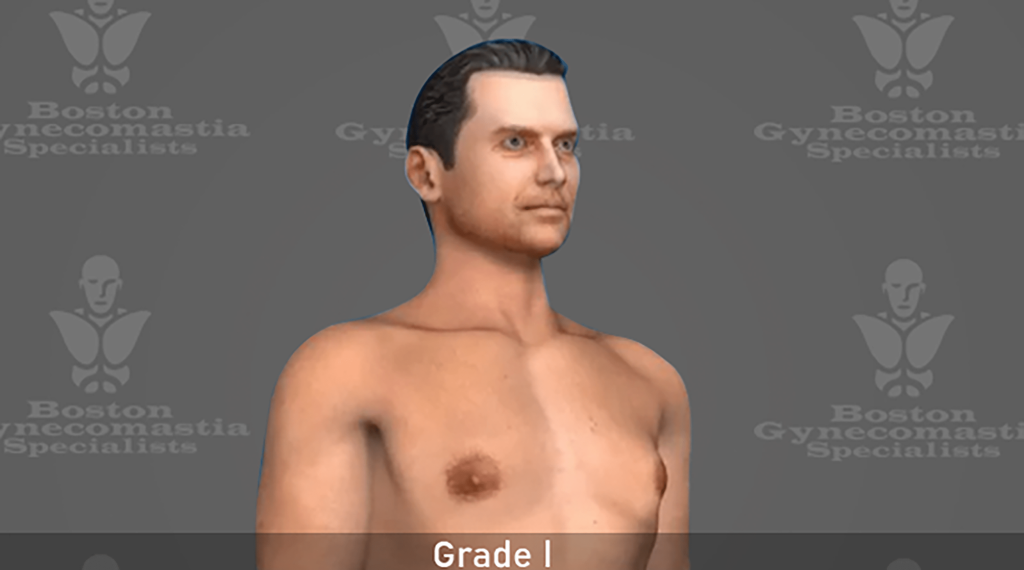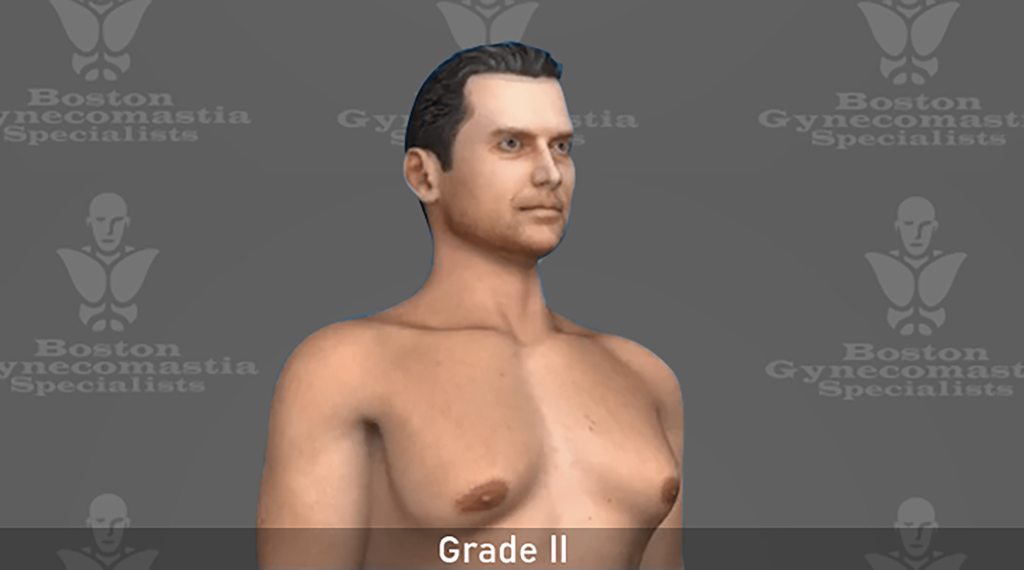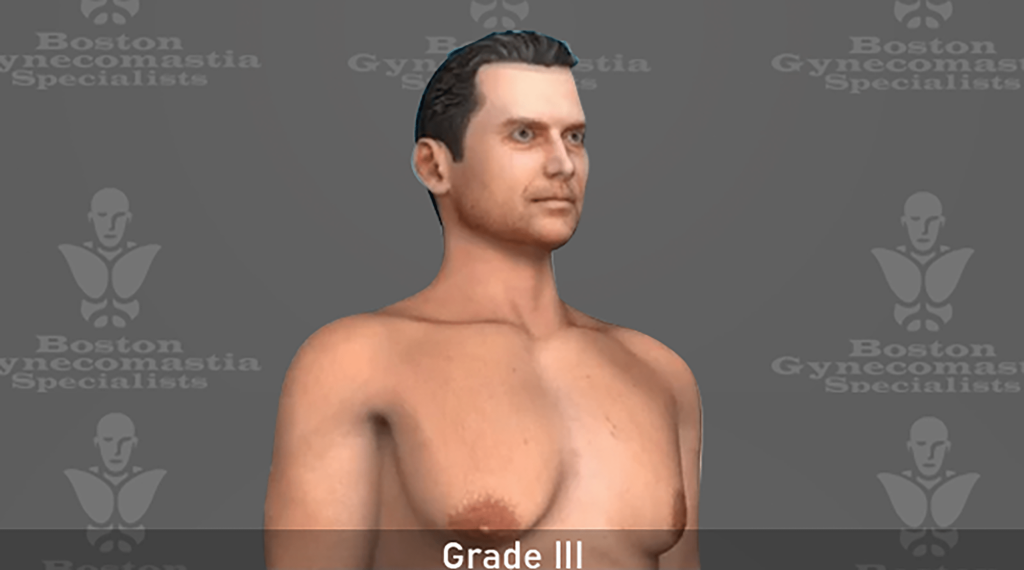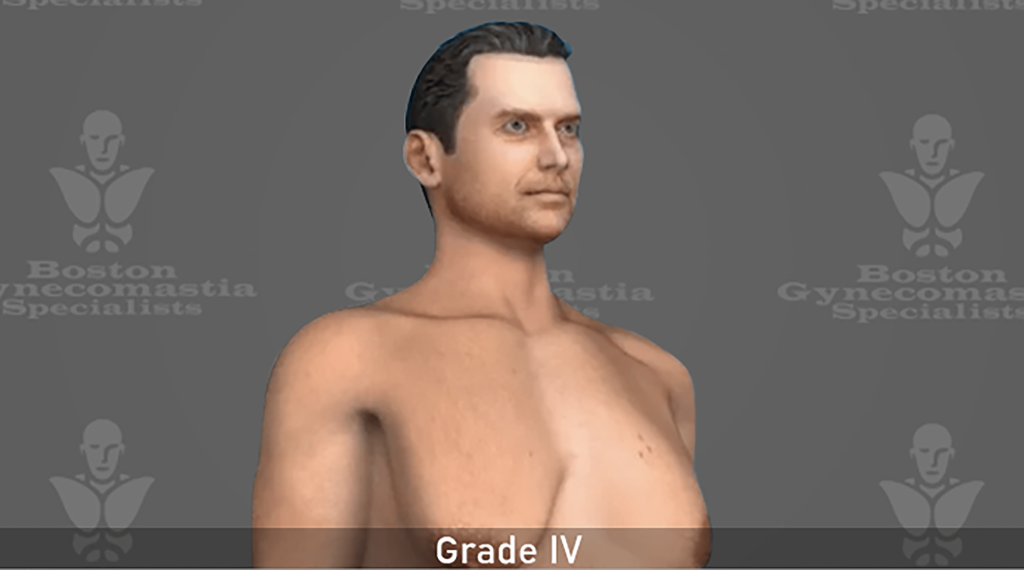
888-380-3222

Expert Male Breast Reduction
A Revolutionary, Minimally Invasive Technique
Customized, Affordable and Innovative Male Breast Reduction in Boston, Massachusetts
Safe and Affordable Gynecomastia Surgery to Regain Masculine Chest Contour
 Due to increasing incidence of obesity at younger ages and changes in our food supply, development of fuller chest in men due to gynecomastia or pseudo-gynecomastia has become very common. By the age of 70, almost 70% percent of men will have signs of enlarged male breast tissue. Most if not all men want to feel comfortable in a tight T shirt or with their shirt off at the beach or in an intimate setting. However, many men who develop gynecomastia feel uncomfortable, self-conscious, or embarrassed by their appearance.
Due to increasing incidence of obesity at younger ages and changes in our food supply, development of fuller chest in men due to gynecomastia or pseudo-gynecomastia has become very common. By the age of 70, almost 70% percent of men will have signs of enlarged male breast tissue. Most if not all men want to feel comfortable in a tight T shirt or with their shirt off at the beach or in an intimate setting. However, many men who develop gynecomastia feel uncomfortable, self-conscious, or embarrassed by their appearance.
While gynecomastia typically manifests in the teenage years, the condition can arise at any time over the age of puberty. Gynecomastia is a complex condition with many potential causes. A singular cause of gynecomastia is unknown, but visible male breast tissue has been known to result from a variety of factors, including:
- Hormonal changes
- Genetics
- Obesity
- Hormonal Imbalance
- Medication: including antidepressants, some antibiotics, AIDS medications, heart medications, ADHD medications, chemotherapy, and anxiety medications.
- Street drugs: including marijuana, heroin, and amphetamines
- Steroid use medical conditions: including kidney failure, thyroid problems, malnutrition, liver problems, and hypogonadism
- Herbal products including products that contain tea tree or lavender oil
- Aging
- Klinefelter Syndrome
What is Gynecomastia?
In general, lingering enlarged breast gland in a man that does not resolve after puberty in spite of correction of any underlying medical conditions, hormonal imbalances, discontinuation of potentially causative medications and maintaining healthy habbits and lifestyle, can be a sign of gynecomastia. Symptoms of the condition may include:
Unilateral or Bilateral overdeveloped breast glands
- Breasts that appear disproportionate
Swelling or protrusion of the nipples
Breast tenderness
If left untreated, gynecomastia can lead to lasting psychological problems, including depression and low self-esteem. If you have chest fullness, talk with your doctor. Some men find the issue resolves itself when underlying medical conditions are treated, medications are adjusted, or lifestyle changes are made. If these don’t provide the desired level of correction, surgery is an effective and permanent solution for this common problem.
A simple surgical procedure called male breast reduction can reduce or remove the unwanted tissue and restore masculine contour to your chest appearance. You can once again, have the confidence to wear form fitting shirts or take your shirt off to enjoy intimacy or to jump in the pool confidently without feeling embarrassed or self-conscious.
Contact Dr. Edwin Ishoo at The Boston Gynecomastia Specialists to learn more about male breast reduction surgery and chest sculpting in Boston, Massachusetts.
Male Breast Reduction Table of Contents
Types of Gynecomastia
Gynecomastia and Pseudogynecomastia are terms used to describe excessive breast fullness in men. As both conditions can look the same—typically creating an enlarged breast appearance—many patients are unsure whether they are affected by one or the other or both.
 The biggest distinction between gynecomastia and pseudogynecomastia is the type of tissue creating the look of increased chest mass. While True Gynecomastia is characterized by one side (unilateral) or both sides (bilateral) excess breast or glandular tissue, which can occur in fit and lean men, pseudogynecomastia refers to breast fullness caused by stubborn fat (adipose tissue). , which usually occurs in overweight or obese men. Pseudogynecomastia can cause many of the same symptoms as gynecomastia, such as physical discomfort, embarrassment and a negative body image.
The biggest distinction between gynecomastia and pseudogynecomastia is the type of tissue creating the look of increased chest mass. While True Gynecomastia is characterized by one side (unilateral) or both sides (bilateral) excess breast or glandular tissue, which can occur in fit and lean men, pseudogynecomastia refers to breast fullness caused by stubborn fat (adipose tissue). , which usually occurs in overweight or obese men. Pseudogynecomastia can cause many of the same symptoms as gynecomastia, such as physical discomfort, embarrassment and a negative body image.
Many men suffer from a combination of these conditions and require a more complex assessment and treatment plan for best result.
Dr. Edwin Ishoo, a highly experienced Gynecomastia Surgeon in Boston, offers treatment for any conditions that may be causing Male Breast Enlargement and can perform an examination to determine the best way to provide the procedure tailored to their specific condition and restore the flat, masculine contour of the chest for your physique.
Grades of Gynecomastia
Grade 1: Mild Enlargement with a lack of Excess Skin

Grade 2: Moderate Enlargement with No Excess Skin Grade
Grade 2 gynecomastia is only slightly more severe than grade one. The condition is characterized by breast growth that extends beyond the areola with indistinct borders along the chest. There may be fatty tissue present alongside glandular tissue but there is not usually any extra skin.

Grade 3: Moderate Enlargement with Excess Skin
Grade 3 gynecomastia bears a similarity to grade 2 with extra skin also present. Men with grade 3 have lost skin elasticity, which causes the skin around the chest to become loose and saggy. Grade 3 gynecomastia usually contains both fatty tissue and glandular tissue.

Grade 4: Severe Enlargement with Excess Skin

Male Breast Reduction Surgery:Why Choose Boston Gynecomastia Specialists
Treating breast development in men often requires a multi-faceted approach
We often combine VASER Liposelection with Power-Assisted Liposuction (to remove fat) and surgical excision (to remove glandular tissue). Most men with breast development have a section of fibrous tissue under the nipple. This tissue won’t go away with weight loss. Treating both the excess fat and the fibrous tissue delivers a masculine chest contour.
Most men will develop breast tissue at some point during their lifetime.
Having breast tissue as a man doesn’t mean you’re overweight or unhealthy. We see this condition in every type of man, including athletes and bodybuilders. In fact, most men will develop breast tissue at some point during their lifetime.
Loss of nipple sensation is common after this procedure.
Loss of nipple sensation is common after this procedure. Most of our patients find the increased confidence offsets any loss in sensation.
We use high-definition techniques.
We use high-definition techniques using advanced tools including VASER Liposelection and Power Assisted Liposuction to define the lateral and inferior border of the chest muscle resulting in a sculpted, masculine appearance.
We use innovative techniques to avoid potentially unsightly scar or deformity.
Dr Edwin Ishoo has developed, ChestSculpt, a patented technique to reduce the enlarged breast gland in the appropriate candidates, through a small lateral puncture, avoiding potentially unsightly areolar scar or fold which can lead to deformity
We typically use a drainless technique or rubber band technique instead of a large drain.
We typically use a drainless technique or rubber band technique instead of a large drain.
We minimize the chance of a scar.
We use port protectors in your skin to minimize the chance of a thick scar from the friction burn due to liposuction.
We minimize risk of anesthesia.
We mainly use local tumescent anesthetic to safely and comfortably perform most Male Breast Reduction Surgeries. Occasionally, we may use inhaled nitrous oxide for additional comfort for those who may need assistance with anxiety during the procedure. We also monitor patients throughout the procedure and recovery period to ensure comfort and safety.
We employ intensive post-surgical care to accelerate recovery and improve cosmetic outcome.
Dr Ishoo utilizes advanced post-lipo care using staged compression garments, ultrasound-assisted massaging techniques and drainage to accelerate healing and maximize skin and areolar contraction to achieve a sculpted, high-definition appearance.
Benefits of Gynecomastia Surgery
Men undergoing Male Breast Reduction surgery report a high rate of patient satisfaction. We’d love to discuss the many benefits of this procedure with you at a consultation.
Potential benefits include:
- Feel more confident in your chest appearance
- Freedom to wear more clothing styles including tight and fitted tops
- Create a masculine chest contour
- Reduce or eliminate teasing
Our patients tell us that the surgery changes how they feel about themselves. They love being able to participate in water and outdoor activities or enjoying intimacy with their partner without worrying about their chest appearance.
Options for Surgical Treatment of Gynecomastia in Boston
There are many options for Male Breast Reduction in New England. At the Boston Gynecomastia Specialists, the premier Gynecomastia Center of Boston, we specialize in assessing the specific type and grade of gynecomastia for each individual. Through a personalized approach, our highly skilled and experienced Gynecomastia Surgeons in Boston develop tailored treatment plans to achieve a more sculpted, masculine chest for each patient. Dr. Edwin Ishoo utilizes advanced techniques and state-of-the-art technology to deliver the highest standard of care.
Talk with our board-certified surgeon, Dr. Edwin Ishoo, to receive personalized consultation regarding the most effective option for you.
Reducing the glandular tissue under the nipple using the ChestSculpt procedure will often resolve puffiness in the nipple or areola. Limited Liposuction may be needed for best result.
In some cases, involving pseudo-gynecomastia, liposuction alone can produce a good result for male breast reduction. Most of the time; however, we combine liposuction with glandular resection or reduction for best result.
The fibrous tissue behind the nipple is removed or reduced and liposuction is performed to contour and shape the chest area.
Some patients who may have significant skin excess or laxity benefit from a two-stage surgery. First, the glandular resection and liposuction are performed. Then, after a course of intensive post-surgical care, we wait for the skin to contract and tighten. After healing, any excess skin that remains may be removed using local anesthetic at our clinic.Some surgeons may use other techniques for male breast reduction, including a full breast reduction with a horizontal scar. This procedure leaves significant scarring. We’ve chosen not to offer this technique as our surgeons achieve better aesthetic results using other surgical methods.
What is the PEXsculpt® Procedure?
Dr. Edwin Ishoo has developed an innovative, minimally invasive technique for effective treatment of Gynecomastia with significant reduction in surgical and recovery time while achieving excellent cosmetic results without infra-aroelar scar or nipple inversion which are common in traditional technique. Dr. Edwin Ishoo, utilizes, VASER liposelection, the most advanced form of ultrasound-assisted fat emulsification and HiDef liposculpting with Power-Assisted Liposuction to achieve a masculine contour of the chest. Once the fat is reduced from front, lateral and inferior borders of the chest and a masculine contour is achieved, the breast gland is precisely reduced and sculpted using a surgical microdebrider / shaver introduced through the same small punctures used for liposuction, thus achieving a sculpted appearance without significant surgical dissection of the chest tissue. The skin envelope of the chest remains intact which results in faster recovery and better contraction against the contoured chest.
At Boston Gynecomastia Specialists, Dr. Edwin Ishoo performs this revolutionary, minimally invasive Male Breast Reduction procedure to improve the contour and shape of the chest for a more masculine appearance. If you suffer from gynecomastia with enlarged breast gland with or without fatty chest and have been avoiding physical activity, the beach or intimacy, the PEXsculpt procedure may be an option for you to regain your confidence and your enjoyment of an active life.
Who is a Good Candidate for Male Breast Reduction?
Having gynecomastia surgery is a highly personal decision and you should do it for yourself, not to fulfill someone else’s desires or to try to fit any sort of ideal image. Many men from locations throughout the United States have undergone Male Breast Reduction by Dr Edwin Ishoo over the years. We typically perform this procedure on:
- Men who are bothered by the feeling that their breasts are too large and are embarrassed to remove their shirt
- Highly athletic men, including bodybuilders, that are in excellent shape, but have some excess breast tissue they want to eliminate
- Men that have lost significant weight and have loose skin or excess fat remaining in the chest area
- Men with chest fullness due to excess fat or breast gland enlargement causing discomfort or deformity
- Men who are physically healthy and of relatively normal weight
- Men who have realistic expectations
- Men with a positive outlook and specific goals n mind for improving the physical symptoms of gynecomastia
- Men whose breast development has stabilize
- Men whose condition cannot be corrected through alternative medical treatments
- Healthy individuals who do not have a life-threatening illness or medical conditions that can impair healing
- Non-smokers and non-drug users
The best candidates are usually at a healthy weight and in overall good health. Adolescents may benefit from surgery, although secondary procedures may be needed in the future should breast development continue. Dr Ishoo can help you decide if male breast reduction is right for you and which approach would achieve your goal during a personal, one-on-one consultation.
Gynecomastia Consultation
During your consultation with Dr Ishoo at our Cambridge, Massachusetts office, you will discuss your concerns about your chest contour and go over your options for male breast reduction surgery. Depending on the severity of your condition, Dr Ishoo may recommend different approaches to surgery to get achieve your optimal results using the most minimally-invasive techniques possible.
You will get the opportunity to ask any questions you may have about your procedure, and you will also learn more about the surgery and recovery process. Our staff at Boston Gynecomastia Specialists will ensure that you are a good candidate for the surgery and make sure you know the benefits and risks of the procedure as well as the realistic expectations of the outcome and the recovery process before you decide to move forward.
Recovery After Gynecomastia Surgery
Recovery after your procedure will depend on the extent of your surgery.
- Post-operative swelling is common, but patients report immediate improvement in their chest contours.
- We will ask you to wear staged compression garments for approximately the first two-to-four weeks after surgery.
- Limit sports and intense physical activity for two to six weeks, depending on the extent of surgery and compliance with post-surgical recovery process.
Most patients experience minimal discomfort and enjoy a quick recovery with our post-surgical recovery process. We’ll provide detailed care instructions prior to your procedure so that you will know what to expect.
Terms You Should Know
- Areola: Pigmented skin surrounding the nipple.
- Unilateral gynecomastia: A condition of over-developed or enlarged breast in men affecting one breast.
- Endocrine system: A group of glands that make hormones which help to control activities in your body such as reproduction, metabolism, growth and development. Testing of your endocrine system may be done to look for signs of diabetes, thyroid disorders, growth hormone deficiency, osteoporosis, hypertension and obesity.
- Excision: Surgical removal of tissue such as fat, breast gland or skin.
- Local anesthesia: Injection of Drugs used during an operation to relieve pain and numb the treatment area without altering consciousness.
- Hematoma: Blood pooling beneath the skin after trauma or surgery.
- Seroma: Collection of clear tissue under the skin after trauma or surgery.
- Liposuction: Also called lipoplasty or suction lipectomy, this procedure vacuums out fat from beneath the skin’s surface to reduce fullness.
- Puffy nipples: Term used to describe grade I gynecomastia with breast gland enlargement limited to the Nipple-Arealar Complex area.
- Reduction mammaplasty: The surgical removal of breast tissue to reduce the size of breasts.
- Sutures: Stitches used by surgeons to hold skin and tissue together.
- Pseudo-gynecomastia: A condition of chest fullness in a man due to only fat deposition and not breast gland over growth.
Before & After Gallery




























































































Frequently Asked Questions
Are results permanent? Will my gynecomastia return after treatment?
The tissue removed through male breast reduction surgery will not come back on its own, and in this sense, the surgery is permanent. However, should the patient not make lifestyle changes, and continues to engage in habits that can prompt gynecomastia or psuedogynecomastia, the problem could reoccur. Weight gain later on could also compromise the results of the surgery, if fat accumulates in the chest area. Most men will not require retreatment and will enjoy lifelong results.
How much work will I miss after gynecomastia surgery?
The amount of time off needed will depend on the extent of your surgery. Most men miss less than a week of work or school.
Can certain exercises treat gynecomastia?
Gynecomastia is usually the result of fatty tissue combined with glandular breast tissue, therefore the effectiveness of chest exercises is limited. While working out the pectoral muscles can indeed reduce the fat and strengthen muscles in the region, there is no exercise regimen that can remove male breast tissue and flatten the chest. For this reason, patients who exercise this region to reduce their gynecomastia usually do not experience the results they desire.
Are there non-surgical options for treating gynecomastia?
Surgery is the most effective and lasting way to eliminate breast tissue in men. Some men find relief by adjusting medications and medical treatments, but in many cases, surgery or liposuction is the quickest and easiest way to resolve the condition.
What are the possible risks of male breast reduction surgery?
- Unfavorable scarring
- Bleeding (Hematoma)
- Blood clots
- Infection
- Poor wound healing
- Changes in nipple or breast sensation may be temporary or permanent
- If liposuction is used, additional risks include uneven contours, rippling or loose skin, irregular pigmentation, excessive fluid loss or fluid accumulation
- Anesthesia risks
- Breast contour and shape irregularities
- Skin discoloration, permanent pigmentation changes, swelling and bruising
- Damage to deeper structures such as nerves, blood vessels, muscles, and lungs can occur and may be temporary or permanent
- Allergies to tape, suture materials, glues, blood products, topical preparations or injected agents
- Breast asymmetry
- Fatty tissue found deep in the skin might die (fat necrosis)
- Fluid accumulation
- Deep vein thrombosis, cardiac and pulmonary complications
- Pain, which may persist
- Possibility of revisional surgery
Will I have gynecomastia surgery scars?
Any surgical procedure can leave small scars, but the incisions made during male breast reduction are typically hidden in the natural contours of the chest and nipples. The visibility of your scars will depend on a number of factors, including the technique used, the amount of tissue removed, the elasticity of your skin, and whether glandular or fatty tissue contributed to your gynecomastia. In some cases, male breast reduction using liposuction or ChestSculpt techniques can lead to a smaller scar than procedures in which glandular tissue must be surgically removed. More importantly, a cosmetic surgeon’s level of experience performing gynecomastia treatment will be the ultimate determinant of how visible your scars will be. As a cosmetic surgeon who focuses on aesthetic surgery, Dr. Ishoo is well-equipped to restore the masculine contours of the chest while incurring as little scarring as possible. He has extensive experience performing male breast reduction and knows which techniques can achieve a natural-looking result. Gynecomastia surgery scars generally heal very well and can fade over time to become even more inconspicuous. Certain measures can be taken to help ensure scars mature properly for an “unoperated” look, such as applying sun protection to avoid hyperpigmentation and keeping incisions from drying out.
Will my chest look natural after male breast reduction?
The goal of male breast reduction is always a natural appearance and a masculine contour to the chest. Only excess breast tissue is removed since all men have some breast gland tissue. Removing additional tissue would affect the chest contours negatively and make the result appear unnatural. When performed by an experienced cosmetic surgeon, male breast reduction results are typically very symmetrical and natural-looking.
How do I know my gynecomastia won’t go away on its own?
It’s always hard to say whether gynecomastia is a passing phase or not, but the fact is that the problem is usually only temporary in newborns and adolescents. Adult men with gynecomastia shouldn’t expect the problem to go away on its own, as once breast gland tissue has formed, it can only be resolved with surgical excision. Furthermore, if gynecomastia is triggered by prescription or illegal drug use, including anabolic steroids, breast growth can reappear after surgery if the drug use is not ceased.
How long will I have to wait to start exercising again after surgery?
Male breast reduction patients are usually anxious to hit the gym after surgery, but it’s important that you take it easy for a while and allow your body to heal before you get back to any strenuous activity. This is especially true for exercises that affect the chest and pectoral muscles, such as weight training. Light activity can be resumed after the initial healing period (about two weeks), but strenuous exercise should wait at least 4-6 weeks on average. Our intensive post-surgical recovery process will help accelerate healing and return to normal activity. Dr Ishoo will give you specific instructions, depending on the nature of your procedure and incisions.
How much does male breast reduction in Boston cost?
Costs for male breast reduction vary, depending on the extent of the procedure and the techniques used. Dr Ishoo will give you a personalized quote after an examination and consultation; however, the cost for a typical Male Breast Reduction procedure performed at Boston Gynecomastia Specialists is $5,500. Although, in some cases, health insurance may cover Male Breast Reduction surgery, we do not accept any insurance for payment.
Breast development in men is a common concern but easily treated. It is important that you entrust your Male Breast Reduction to an experienced surgeon performing this procedure. Dr. Edwin Ishoo has extensive experience with using the VASER™ and the microdebrider in chest contouring. Learn more by contacting Boston Gynecomastia Specialists to schedule your gynecomastia consultation in Boston, MA.

